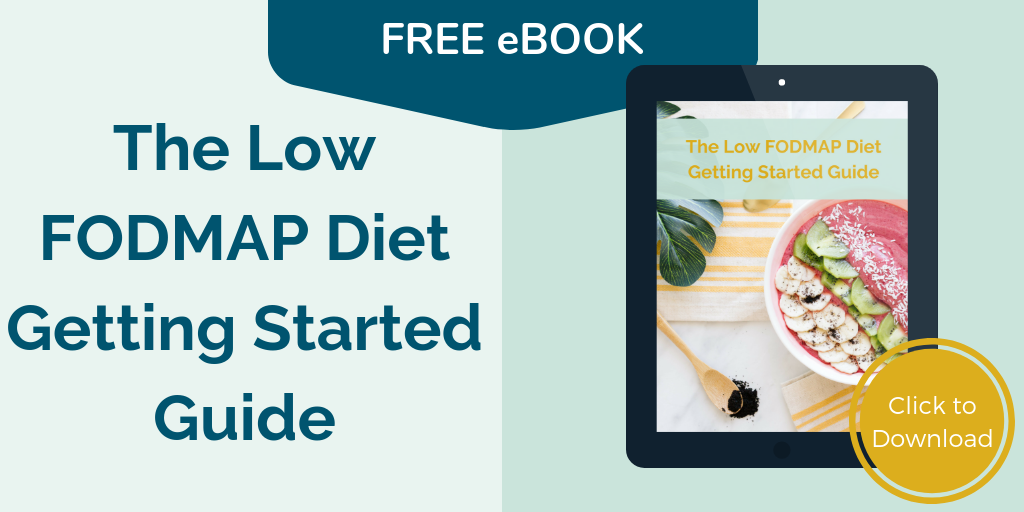March is Nutrition Month, and this year the campaign focuses on making small changes, one meal at a time. I love this idea! Change is hard! I am a big believer that sticking to small, achievable steps will gradually help you achieve the big change you want to make. We all have habits that could use some improvement, whether they have to do with food, wellness, health, or some other nasty little habit we KNOW we need to change. You can do it – it just takes some motivation, mindfulness and often the help of an expert 😉
This year’s Nutrition Month campaign describes 5 strategies you can use to help gradually move towards healthier meal habits. In today’s post, we are going to focus on Nutrition Month Strategy #5 – Make Healthy Eating Stick! – and apply it to digestive health (of course!).
Healthy Low FODMAP Habits for IBS
Short on time? Stressed out? Stuck in meetings all day? There are many barriers to starting (and maintaining!) healthy habits. If you have IBS and have recently started to make dietary changes or to follow the low FODMAP diet as part of a treatment plan to reduce symptoms (like gas, bloating, discomfort, diarrhea or constipation), you probably already know how difficult dietary changes can be!
And it’s why I created the Low FODMAP Diet Getting Started Guide. It’s a short eBook that will help you better understand the Low FODMAP diet so you know what you need to know about FODMAPs and if this diet is right for you. Click here to get a copy emailed to you now.
It’s absolutely challenging to eliminate key foods from your diet that you enjoy every day for the several months that it takes to see symptom improvement. Hang in there! It’s totally worth it. I’ve seen first-hand how successful the diet can be in relieving symptoms and improving quality of life as I have worked with hundreds of clients to improve their digestive health.
Here are the Top 3 Tips for Sticking to low FODMAP diet.

Top 3 Tips for Following a Low FODMAP Diet
1. Learn to cook low FODMAP recipes
The most successful way to figure out what is triggering your digestive symptoms, heal the gut and experience symptom improvement is to follow an elimination diet. Learn more about this on my latest segment on The Social here.
The low FODMAP diet is the only diet that scientific research shows helps over 75% of people with IBS experience symptom improvement and it’s one of the main strategies we talk about on this blog! If you’ve heard of it before, you may already know that following this diet means eliminating some very common foods like onions, garlic or wheat. It can feel overwhelming at first, but don’t worry, we are here to support you and hopefully get you feeling the best you have in years!
A really easy way to make this new diet stick is by finding some recipes that you love and that are easy to make. I’m constantly creating new recipes for the blog so check back frequently so you don’t miss them, or sign up to the newsletter to get free updates. Here are some of popular recipes that are really easy (and delicious!).
Turkey & Swiss Baked Monte Cristo Sandwich
2. Plan meals ahead
What better way to avoid greasy fast food likely to cause you digestive distress than to have packed some satisfying and great tasting low FODMAP eats.
To get the fastest, most effective results and get back to feeling like your normal self, it’s important to stick as close to the diet as possible during the elimination phase (which is recommended for just 8 to 12 weeks). A major key to your success in sticking to the low FODMAP diet is planning ahead.
A thoughtful, well planned lunch (or snack) will help you stay on track. I’ve got lots of resources on the blog to help you plan ahead so you can feel your best during your afternoon meeting, cocktail hour with your friends or at your child’s sports game. Read the following posts for help on meal planning:
A take anywhere low FODMAP trail mix recipe
Low FODMAP food choices from common restaurants
How to create a lunch you love
3. Work with a professional
It’s tough to make any changes in our lives, especially those surrounding diet. Eliminating foods can cause low energy, poor sleep, anxiety and other issues.
I strongly encourage people who are considering the Low FODMAP diet to work with a Registered Dietitian who is an expert in digestive nutrition. By working with someone who really knows the diets – they can help you with meal planning, recipes, grocery shopping and trouble shooting so you stay healthy and motivated. This is the case when making ANY dietary changes!… or any changes at all!
These small steps can make a huge difference in the outcome of your success on the low FODMAP diet! How do you stick to the low FODMAP diet? Let us know in the comments below!
Wishing you good gut health & wellness,
Stephanie and the Team


